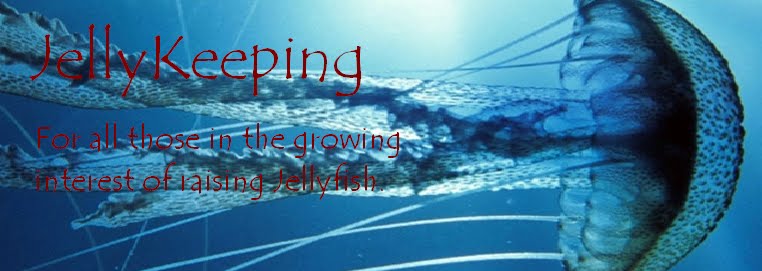There are many things you can feed your jellyfish. Frozen foods, live plankton, liquefied plankton, etc. However, there are two you should stick with. Frozen Plankton meant for Jellies and Live Baby Brine Shrimp. In this post, I'll be discussing the pros and cons to each type of food.
Frozen Plankton meant for JelliesYou can buy it from JellyFishArt.com and many other stores online. The reason it has been accepted is because it is so easy. Unfortunately, frozen food can be a bit expensive. You just cut a piece of food, thaw it, and drop it in. Although it must be squirted directly into the jelly's mouths. This is because it's dead so it won't stay suspended for long. The jellies need as much food as possible before all the little plankton fall down to the bottom. Also, you will need to do more constant water changes with using dead food. As they sit in the water, they foul it and release bad stuff into your water. In open-bottom tanks, it is easy to clean up the mess. However, in tanks with substrates (glass marbles, rock, sand, etc.) it is much harder to remove the organisms and you may need something to clean up your leftovers. I'll talk about Jellyfish Tank Mates on another post. Anothe problem with frozen foods is that they will fog up your aquarium water. They have dead parts to the plankton floating around and all the stuff that was frozen in with them.
Here are some sites that sell frozen food:
http://www.jellyfishart.com/Frozen-Jellyfish-Food-p/food6oz.htmhttp://sunsetmarinelabs.com/jellyfish-food/Live Baby Brine ShrimpThe other most common food is Live Baby Brine Shrimp or artemia nauplii. They are easily hatched in a brine shrimp hatchery. The eggs are also, for the most part, inexpensive. That basically consists of a 2 liter bottle with the bottom cut off. Its
turned upside down and has airline tubing comming up from the hole where the cap would be (something keeps water from coming out from the bottom, yet allows the airline to put air in the water. It's filled up with saltwater and eggs are added. The airline is attached to an air pump (obviously before it's filled up with water). The bubbles keep the water circulated. Then it must be allowed to sit for about 24 hours with the bubbler on. The egg shells fill up with water and hatch. The brine shrimp are then removed and soaked in an enrichment (I use Selcon). Then they can be fed to the jellies.
There is one thing I hate about raising brine shrimp though. That is separating the egg shells and unhatched eggs from the live shrimp. The egg shells and unhatched eggs can get caught in the jelly's digestive track and hurt them. There is almost no way to completely seperate the egg shells from the live shrimp. However, there is a solution. It's called decapsulated brine shrimp eggs. Most decapsulated brine shrimp eggs you find will be non hatchable (or they are dead). They must be fed directly as eggs. They are 100% digestable. However, I have found some decapsulated eggs from BrineShrimpDirect.com. Here's a link:
http://www.brineshrimpdirect.com/c1/c2/Shell-Free-E-Z-Egg-c202.html
I ordered some and I'll let you know how they work out as soon as I get them and try them out.
 ARTEMIA NAUPLIINow, the benefits to live food,
ARTEMIA NAUPLIINow, the benefits to live food,
Live baby brine shrimp have a yolk sac for the first 24 hours of their life. This is the most nutritious part. The yolk sac will help grow your baby jellyfish and keep your adult jellies healthy. Live food will also stay suspended in the water all by itself. No more falling to the bottom and rotting. They don't make your water cloudy because they aren't falling into pieces and getting torn up.
Frozen food is easy and saves time. Live food, though, keeps your jellies healthier and keeps your water cleaner. Live food also takes up more time. And, frozen food is a bit more expensive then brine shrimp eggs. You may end up spending more time doing water changes and conditioning the water with frozen food.
It's really your choice. I do live food because it seems more practical.
If you've ever heard of LAFISHGUY (a web show one youtube), he evaluates live and frozen food as well.
So good luck finding a food that suits you!











